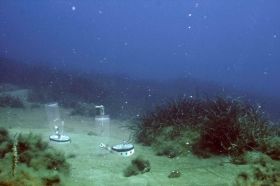Day-in, day-out, we release nearly 100 million tons of carbon dioxide (CO2) into the atmosphere. One possible measure against steadily increasing greenhouse gases is known as CCS (carbon capture and storage): Here, the carbon dioxide is captured, preferably directly at the power plant, and subsequently stored deep in the ground or beneath the seabed. However, this method poses the risk of reservoirs leaking and allowing carbon dioxide to escape from the ground into the environment. The European research project ECO2, coordinated at GEOMAR Helmholtz Centre for Ocean Research Kiel, addresses the question of how marine ecosystems react to such CO2-leaks. The field study of an international group of researchers headed by Massimiliano Molari from the Max Planck Institute for Marine Microbiology in Bremen and Katja Guilini from the University of Ghent in Belgium, now published in Science Advances, reveals how leaking CO2 affects the seabed habitat and its inhabitants.
For their study, the researchers visited natural leaks of CO2 in the sandy seabed off the coast of Sicily. They compared the local ecosystem with locations without CO2-venting. In addition, they exchanged sand between sites with and without CO2-venting in order to study how the bottom-dwellers respond and if they can adapt. Their conclusion: Increased CO2 levels drastically alter the ecosystem.
Continue reading at Max Planck Institute for Marine Microbiology
Image via C. Lott, HYDRA


